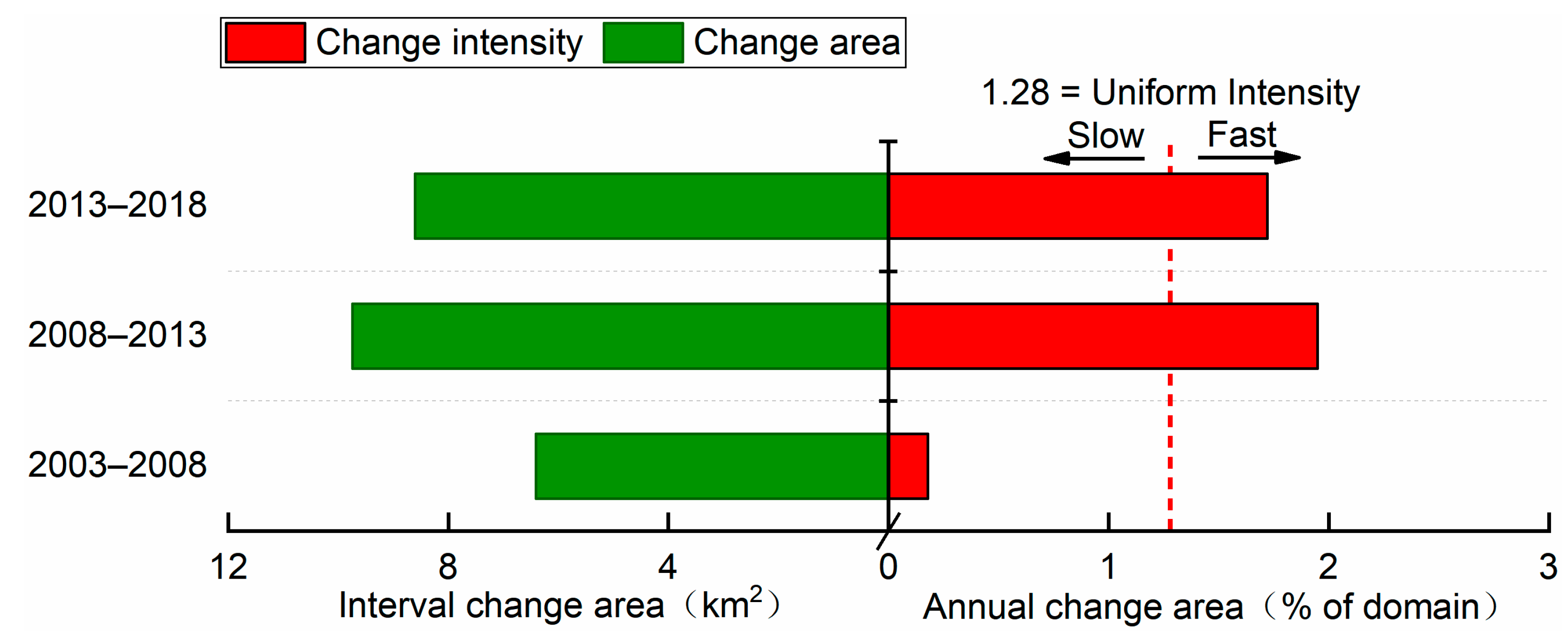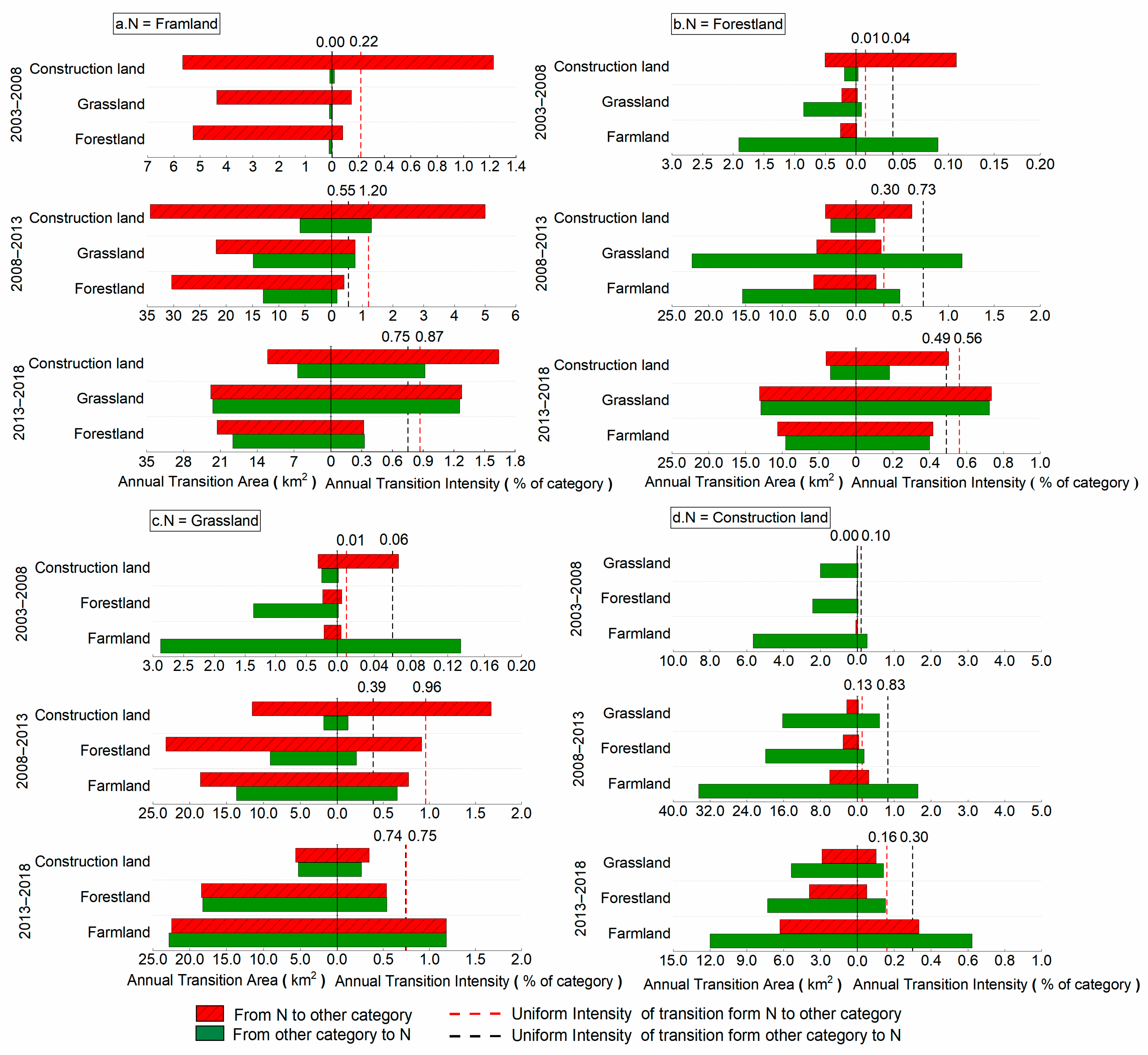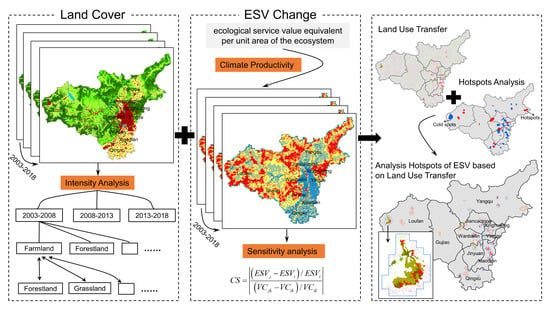Response of Ecosystem Service Value to Spatio-Temporal Pattern Evolution of Land Use in Typical Heavy Industry Cities: A Case Study of Taiyuan City, China
Abstract
1. Introduction
2. Materials and Methods
2.1. Study Area
2.2. Data Sources and Processing
2.3. Intensity Analysis
2.4. Ecosystem Services Value Calculation
2.5. Sensitivity Analysis
3. Results
3.1. Analysis of Spatio-Temporal Characteristics of Land Use
3.2. Analysis of Spatio-Temporal Characteristics of Land Use
3.2.1. Interval Level
3.2.2. Category Level
3.2.3. Transition Level
3.3. Analysis of Changes in ESV
3.3.1. The Spatial-Temporal Pattern of ESV
3.3.2. Sensitivity Analysis
3.3.3. Analysis of ESV Cold and Hot Spots Based on Land Use Transfer
4. Discussion
5. Conclusions
Author Contributions
Funding
Institutional Review Board Statement
Informed Consent Statement
Data Availability Statement
Conflicts of Interest
References
- Daily, G.C. Nature’s Services: Societal Dependence on Natural Ecosystems (1997). In Nature’s Services: Societal Dependence on Natural Ecosystems (1997); Yale University Press: New Haven, CT, USA, 2013; pp. 454–464. ISBN 978-0-300-18847-9. [Google Scholar]
- Costanza, R.; d’Arge, R.; de Groot, R.; Farber, S.; Grasso, M.; Hannon, B.; Limburg, K.; Naeem, S.; O’Neill, R.V.; Paruelo, J.; et al. The Value of the World’s Ecosystem Services and Natural Capital. Nature 1997, 387, 253–260. [Google Scholar] [CrossRef]
- Reid, W.V. Millennium Ecosystem Assessment; World Resources Institute: Washington, DC, USA, 2005. [Google Scholar]
- Xie, L.; Wang, H.; Liu, S. The Ecosystem Service Values Simulation and Driving Force Analysis Based on Land Use/Land Cover: A Case Study in Inland Rivers in Arid Areas of the Aksu River Basin, China. Ecol. Indic. 2022, 138, 108828. [Google Scholar] [CrossRef]
- Sutton, P.C.; Anderson, S.J.; Costanza, R.; Kubiszewski, I. The Ecological Economics of Land Degradation: Impacts on Ecosystem Service Values. Ecol. Econ. 2016, 129, 182–192. [Google Scholar] [CrossRef]
- Wang, J.; Dun, Y. A Review on the Effects of Land Use Change on Ecosystem Services. Resour. Environ. Yangtze Basin 2015, 24, 798–808. [Google Scholar] [CrossRef]
- Fu, B.; Zhang, L. Land-Use Change and Ecosystem Services: Concepts, Methods and Progress. Prog. Geogr. 2014, 33, 441–446. [Google Scholar] [CrossRef]
- Khaledian, Y.; Kiani, F.; Ebrahimi, S.; Brevik, E.C.; Aitkenhead-Peterson, J. Assessment and Monitoring of Soil Degradation during Land Use Change Using Multivariate Analysis. Land Degrad. Dev. 2017, 28, 128–141. [Google Scholar] [CrossRef]
- Erener, A. Remote Sensing of Vegetation Health for Reclaimed Areas of Seyitömer Open Cast Coal Mine. Int. J. Coal Geol. 2011, 86, 20–26. [Google Scholar] [CrossRef]
- Hou, H.; Ding, Z.; Zhang, S.; Guo, S.; Yang, Y.; Chen, Z.; Mi, J.; Wang, X. Spatial Estimate of Ecological and Environmental Damage in an Underground Coal Mining Area on the Loess Plateau: Implications for Planning Restoration Interventions. J. Clean. Prod. 2021, 287, 125061. [Google Scholar] [CrossRef]
- Ji, S.; Ma, S. The Effects of Industrial Pollution on Ecosystem Service Value: A Case Study in a Heavy Industrial Area, China. Environ. Dev. Sustain. 2022, 24, 6804–6833. [Google Scholar] [CrossRef]
- Qian, D.; Yan, C.; Xing, Z.; Xiu, L. Monitoring Coal Mine Changes and Their Impact on Landscape Patterns in an Alpine Region: A Case Study of the Muli Coal Mine in the Qinghai-Tibet Plateau. Environ. Monit. Assess. 2017, 189, 559. [Google Scholar] [CrossRef]
- National Remote Sensing Center of China Sustainable Development Trend of Global Terrestrial Ecosystems. Available online: http://old.chinageoss.cn/geoarc/2021/ (accessed on 25 September 2022).
- Long, K.; Omrani, H.; Pijanowski, B.C. Impact of Local Payments for Ecosystem Services on Land Use in a Developed Area of China: A Qualitative Analysis Based on an Integrated Conceptual Framework. Land Use Policy 2020, 96, 104716. [Google Scholar] [CrossRef]
- Najmuddin, O.; Li, Z.; Khan, R.; Zhuang, W. Valuation of Land-Use/Land-Cover-Based Ecosystem Services in Afghanistan—An Assessment of the Past and Future. Land 2022, 11, 1906. [Google Scholar] [CrossRef]
- Romero-Ruiz, M.H.; Flantua, S.G.A.; Tansey, K.; Berrio, J.C. Landscape Transformations in Savannas of Northern South America: Land Use/Cover Changes since 1987 in the Llanos Orientales of Colombia. Appl. Geogr. 2012, 32, 766–776. [Google Scholar] [CrossRef]
- Zhang, C.; Zhao, L.; Zhang, H.; Chen, M.; Fang, R.; Yao, Y.; Zhang, Q.; Wang, Q. Spatial-Temporal Characteristics of Carbon Emissions from Land Use Change in Yellow River Delta Region, China. Ecol. Indic. 2022, 136, 108623. [Google Scholar] [CrossRef]
- Zhao, Q.; Wen, Z.; Chen, S.; Ding, S.; Zhang, M. Quantifying Land Use/Land Cover and Landscape Pattern Changes and Impacts on Ecosystem Services. Int. J. Environ. Res. Public. Health 2020, 17, 126. [Google Scholar] [CrossRef]
- Yao, Z.; Wang, B.; Huang, J.; Zhang, Y.; Yang, J.; Deng, R.; Yang, Q. Analysis of Land Use Changes and Driving Forces in the Yanhe River Basin from 1980 to 2015. J. Sens. 2021, 2021, 1–11. [Google Scholar] [CrossRef]
- Li, S.; Dong, B.; Gao, X.; Xu, H.; Ren, C.; Liu, Y.; Peng, L. Study on Spatio-Temporal Evolution of Habitat Quality Based on Land-Use Change in Chongming Dongtan, China. Environ. Earth Sci. 2022, 81, 220. [Google Scholar] [CrossRef]
- Qiao, W.; Sheng, Y.; Fang, B.; Wang, Y. Land Use Change Information Mining in Highly Urbanized Area Based on Transfer Matrix: A Case Study of Suzhou, Jiangsu Province. Geogr. Res. 2013, 32, 1497–1507. [Google Scholar]
- Yang, Y.; Xia, X.; Zhao, X. Study on the land use/cover changes in Xiushan Island based on intensity analytical method. J. Mar. Sci. 2015, 33, 17–25. [Google Scholar] [CrossRef]
- Pontius, R.G.; Shusas, E.; McEachern, M. Detecting Important Categorical Land Changes While Accounting for Persistence. Agric. Ecosyst. Environ. 2004, 101, 251–268. [Google Scholar] [CrossRef]
- Aldwaik, S.Z.; Pontius, R.G. Intensity Analysis to Unify Measurements of Size and Stationarity of Land Changes by Interval, Category, and Transition. Landsc. Urban Plan. 2012, 106, 103–114. [Google Scholar] [CrossRef]
- Huang, B.; Huang, J.; Gilmore Pontius, R.; Tu, Z. Comparison of Intensity Analysis and the Land Use Dynamic Degrees to Measure Land Changes Outside versus inside the Coastal Zone of Longhai, China. Ecol. Indic. 2018, 89, 336–347. [Google Scholar] [CrossRef]
- Pontius, R.G.; Gao, Y.; Giner, N.M.; Kohyama, T.; Osaki, M.; Hirose, K. Design and Interpretation of Intensity Analysis Illustrated by Land Change in Central Kalimantan, Indonesia. Land 2013, 2, 351–369. [Google Scholar] [CrossRef]
- Mallinis, G.; Koutsias, N.; Arianoutsou, M. Monitoring Land Use/Land Cover Transformations from 1945 to 2007 in Two Peri-Urban Mountainous Areas of Athens Metropolitan Area, Greece. Sci. Total Environ. 2014, 490, 262–278. [Google Scholar] [CrossRef] [PubMed]
- Niu, L.; Zhang, B.; Jia, T.; She, D. Analysis on Intensity and Stability of Land Use Change in Haixi Mongolian and Tibetan Autonomous Prefecture of Qinghai Province. J. Soil Water Conserv. 2021, 35, 152–159. [Google Scholar] [CrossRef]
- Wang, Z.; Zhang, B.; Zhang, S. Study on the Effects of Land Use Change on Ecosystem Service Values of Jilin Province. J. Nat. Resour. 2004, 19, 55–61. [Google Scholar] [CrossRef]
- Xie, G.; Zhen, L.; Lu, C.; Xiao, Y.; Chen, C. Expert Knowledge Based Valuation Method of Ecosystem Services in China. J. Nat. Resour. 2008, 23, 911–919. [Google Scholar]
- Bao, D.; Li, J.; Liu, F.; Hu, J. Impact of land-use/land-cover change on ecosystem service values in Myanmar from 1995 to 2015. Acta Ecol. Sin. 2021, 6960–6969. [Google Scholar] [CrossRef]
- Xie, G.; Zhang, C.; Zhang, L.; Chen, W.; Li, S. Improvement of the Evaluation Method for Ecosystem Service Value Based on per Unit Area. J. Nat. Resour. 2015, 30, 1243. [Google Scholar]
- Shi, H.; Shi, X.; Liu, L.; He, J.; Liu, W.; Wan, H. Comparison on Methods and Results of Urban Ecological System Service Value in Lanzhou City. China Popul. Res. Environ. 2013, 23, 30–35. [Google Scholar] [CrossRef]
- Li, Y.; Han, L.; Zhu, H.; Zhao, Y.; Liu, Z.; Chen, R. Changes of Ecological Service Value in Yan´an City Pre and Post Returning Farmland to Forestland Based on Land Use. J. Northwest For. Univ. 2020, 203–211. [Google Scholar] [CrossRef]
- Fang, L.; Cai, J.; Liu, Y.; Yang, B. Spatial Pattern and Dynamic Evolution of Value of HuoShan County during 1990 to 2020. Resour. Ind. 2022, 24, 119. [Google Scholar] [CrossRef]
- Xiao, Q.; Xiao, Y.; Ouyang, Z.Y.; Xu, W.H.; Xiang, S.; Li, Y.Z. Value Assessment of the Function of the Forest Ecosystem Services in Chongqing. Acta Ecol. Sin. 2014, 34. [Google Scholar] [CrossRef]
- Song, W.; Deng, X. Land-Use/Land-Cover Change and Ecosystem Service Provision in China. Sci. Total Environ. 2017, 576, 705–719. [Google Scholar] [CrossRef]
- Xing, L.; Xue, M.; Wang, X. Spatial Correction of Ecosystem Service Value and the Evaluation of Eco-Efficiency: A Case for China’s Provincial Level. Ecol. Indic. 2018, 95, 841–850. [Google Scholar] [CrossRef]
- Anley, M.A.; Minale, A.S.; Haregeweyn, N.; Gashaw, T. Assessing the Impacts of Land Use/Cover Changes on Ecosystem Service Values in Rib Watershed, Upper Blue Nile Basin, Ethiopia. Trees For. People 2022, 7, 100212. [Google Scholar] [CrossRef]
- National Bureau of Statistics of China. Statistical Communiqué of National Economic and Social Development of Taiyuan City in 2018. Available online: http://stats.taiyuan.gov.cn/doc/2019/05/14/845586.shtml (accessed on 25 September 2022).
- Zhou, G.; Zheng, Y.; Luo, T.; Chen, S. NPP Model of Natural Vegetation and Its Application in China. Sci. Silvae Sin. 1998, 34, 2. [Google Scholar]
- Han, W.; Han, Y.; Yang, S. Spatial-Temporal Change of Climate Resources and Climatic Productivity in Shandong Province during 1961–2011. Prog. Geogr. 2013, 32, 425. [Google Scholar] [CrossRef]
- Mankiw, N.G. Principles of Economics, 3rd ed.; Mason ThomsonSouth-Western: Mason, OH, USA, 2004. [Google Scholar]
- Ma, X.; Su, Y.; Lin, F.; Dai, C. Land use/cover change and its driving factors in Taiyuan city. Ecol. Sci. 2021, 40, 201–210. [Google Scholar] [CrossRef]
- Sang, X.; Guo, Q.; Wu, X.; Fu, Y.; Xie, T.; He, C.; Zang, J. Intensity and Stationarity Analysis of Land Use Change Based on CART Algorithm. Sci. Rep. 2019, 9, 12279. [Google Scholar] [CrossRef]
- Ma, L.; Su, H. Land use dynamic change in Guyuan County of Hebei Province. J. Arid Land Resour. Environ. 2010, 24, 131–136. [Google Scholar] [CrossRef]
- Lu, C.; Yang, Q.; Jin, D.; Li, X.; Wen, F. Research Progress and Prospects of the Researches on Urban Land Use Structure in China. Prog. Geogr. 2010, 29, 861–868. [Google Scholar] [CrossRef]
- Sun, Y.; Guo, T.; Cui, X. Intensity Analysis and Stationarity of Land Use Change in Kunming City. Prog. Geogr. 2016, 35, 245–254. [Google Scholar] [CrossRef]
- Wang, Y.; Ding, J.; Li, X.; Zhang, J.; Ma, G. Impact of LUCC on Ecosystem Services Values in the Yili River Basin Based on an Intensity Analysis Model. Acta Ecol. Sin. 2022, 42, 3106–3118. [Google Scholar] [CrossRef]
- Geng, X.; Zhang, J.; Wei, C.; Cheng, M. Study on the change of land use intensity in mining cities based on multi level decision:take Wuan city of Hebei province as an example. China Min. Mag. 2018, 27, 106–112. [Google Scholar] [CrossRef]
- Aldwaik, S.Z.; Pontius, R.G., Jr. Map Errors That Could Account for Deviations from a Uniform Intensity of Land Change. Int. J. Geogr. Inf. Sci. 2013, 27, 1717–1739. [Google Scholar] [CrossRef]
- Tankpa, V.; Wang, L.; Atanga, R.A.; Awotwi, A.; Guo, X. Evidence and Impact of Map Error on Land Use and Land Cover Dynamics in Ashi River Watershed Using Intensity Analysis. PLoS ONE 2020, 15, e0229298. [Google Scholar] [CrossRef] [PubMed]
- Liu, Y.; Li, J.; Zhang, H. An Ecosystem Service Valuation of Land Use Change in Taiyuan City, China. Ecol. Model. 2012, 225, 127–132. [Google Scholar] [CrossRef]
- Xie, G.; Lu, C.; Cheng, S. Progress in Evaluating the Global Ecosystem Services. Resour. Sci. 2001, 23, 5–9. [Google Scholar]
- Gao, X.; Fang, C.; Mu, X.; Chen, D. Coupling and Coordination Analysis of Urbanization and Ecosystem Service Value in Beijing-Tianjin-Hebei Urban Agglomeration. Ecol. Indic. 2022, 137, 108782. [Google Scholar] [CrossRef]
- Xiao, R.; Lin, M.; Fei, X.; Li, Y.; Zhang, Z.; Meng, Q. Exploring the Interactive Coercing Relationship between Urbanization and Ecosystem Service Value in the Shanghai–Hangzhou Bay Metropolitan Region. J. Clean. Prod. 2020, 253, 119803. [Google Scholar] [CrossRef]







| Primary Type | Secondary Type | Forest | Grassland | Farmland | Wetland & Rivers and Lakes | Desserts |
|---|---|---|---|---|---|---|
| Land Use | Forestland | Grassland | Farmland | Waterbody | Unused Land | |
| Supply services | Food production | 75.58 | 98.49 | 229.04 | 101.92 | 4.58 |
| Raw material production | 682.54 | 82.46 | 89.33 | 67.57 | 9.16 | |
| Regulatory services | Gas regulation | 989.46 | 343.56 | 164.91 | 334.40 | 13.74 |
| Climate regulation | 932.20 | 357.31 | 222.17 | 1787.67 | 29.77 | |
| Hydrological regulation | 936.78 | 348.14 | 176.36 | 3688.71 | 16.03 | |
| Waste disposal | 393.95 | 302.33 | 318.37 | 3349.73 | 59.55 | |
| Support Services | Soil conservation | 920.74 | 513.05 | 336.69 | 274.85 | 38.94 |
| Protection of biodiversity | 1032.97 | 428.31 | 233.62 | 815.39 | 91.62 | |
| Cultural services | Provision of aesthetic landscape | 476.40 | 199.27 | 38.94 | 1045.57 | 54.97 |
| Total | 6440.63 | 2673.36 | 1809.42 | 11465.79 | 318.37 | |
| Ecosystems | VC | 2003 | 2008 | 2013 | 2018 | 2003–2018 |
|---|---|---|---|---|---|---|
| Farmland | VC ± 50% | 0.156 | 0.152 | 0.141 | 0.139 | −0.017 |
| Forestland | VC ± 50% | 0.599 | 0.602 | 0.632 | 0.631 | 0.031 |
| Grassland | VC ± 50% | 0.206 | 0.207 | 0.193 | 0.193 | −0.013 |
| Water body | VC ± 50% | 0.039 | 0.039 | 0.034 | 0.037 | −0.002 |
| Unused land | VC ± 50% | 0.000 | 0.000 | 0.000 | 0.000 | 0.000 |
Publisher’s Note: MDPI stays neutral with regard to jurisdictional claims in published maps and institutional affiliations. |
© 2022 by the authors. Licensee MDPI, Basel, Switzerland. This article is an open access article distributed under the terms and conditions of the Creative Commons Attribution (CC BY) license (https://creativecommons.org/licenses/by/4.0/).
Share and Cite
Ding, X.; Zhao, W.; Yan, T.; Wang, L. Response of Ecosystem Service Value to Spatio-Temporal Pattern Evolution of Land Use in Typical Heavy Industry Cities: A Case Study of Taiyuan City, China. Land 2022, 11, 2035. https://doi.org/10.3390/land11112035
Ding X, Zhao W, Yan T, Wang L. Response of Ecosystem Service Value to Spatio-Temporal Pattern Evolution of Land Use in Typical Heavy Industry Cities: A Case Study of Taiyuan City, China. Land. 2022; 11(11):2035. https://doi.org/10.3390/land11112035
Chicago/Turabian StyleDing, Xue, Weijun Zhao, Tingting Yan, and Lan Wang. 2022. "Response of Ecosystem Service Value to Spatio-Temporal Pattern Evolution of Land Use in Typical Heavy Industry Cities: A Case Study of Taiyuan City, China" Land 11, no. 11: 2035. https://doi.org/10.3390/land11112035
APA StyleDing, X., Zhao, W., Yan, T., & Wang, L. (2022). Response of Ecosystem Service Value to Spatio-Temporal Pattern Evolution of Land Use in Typical Heavy Industry Cities: A Case Study of Taiyuan City, China. Land, 11(11), 2035. https://doi.org/10.3390/land11112035







